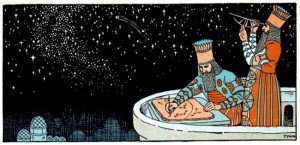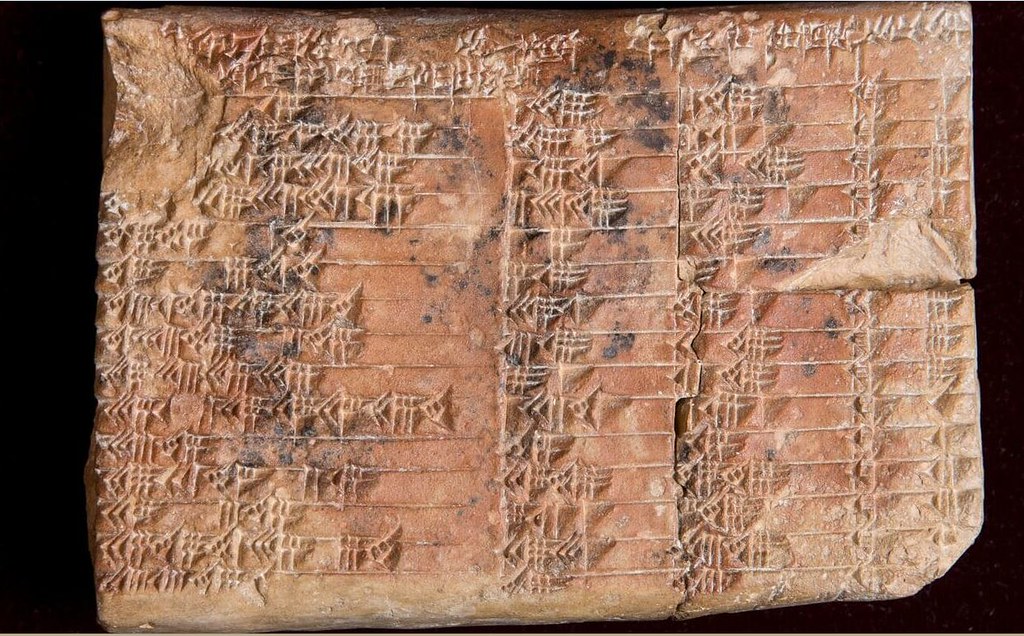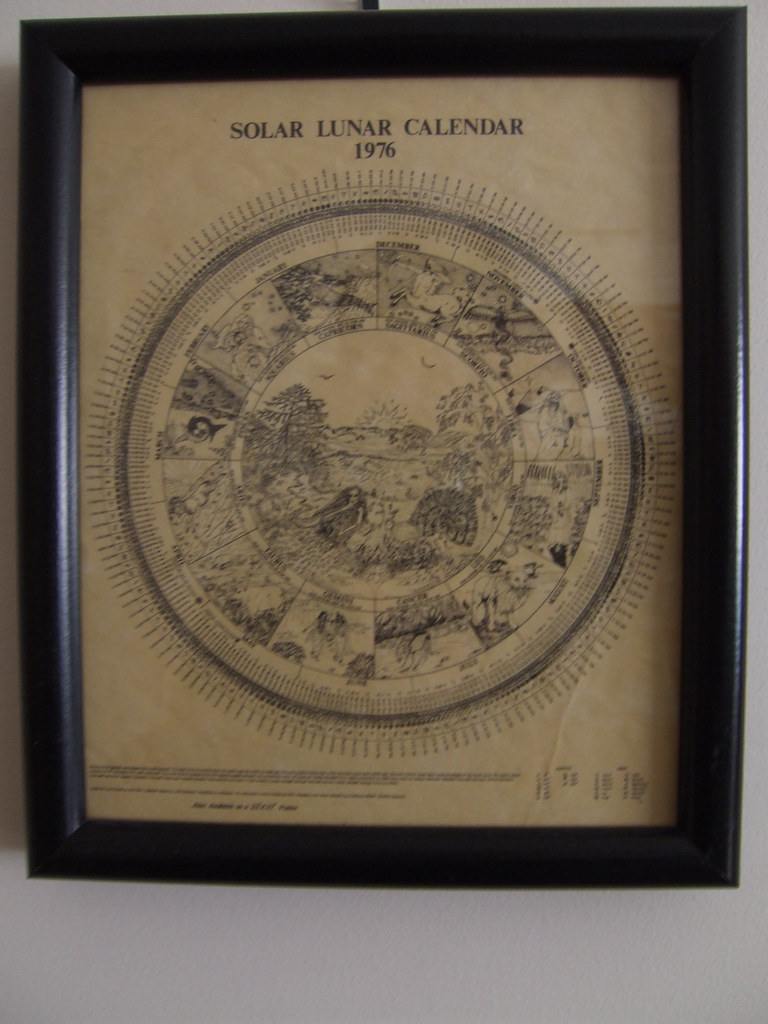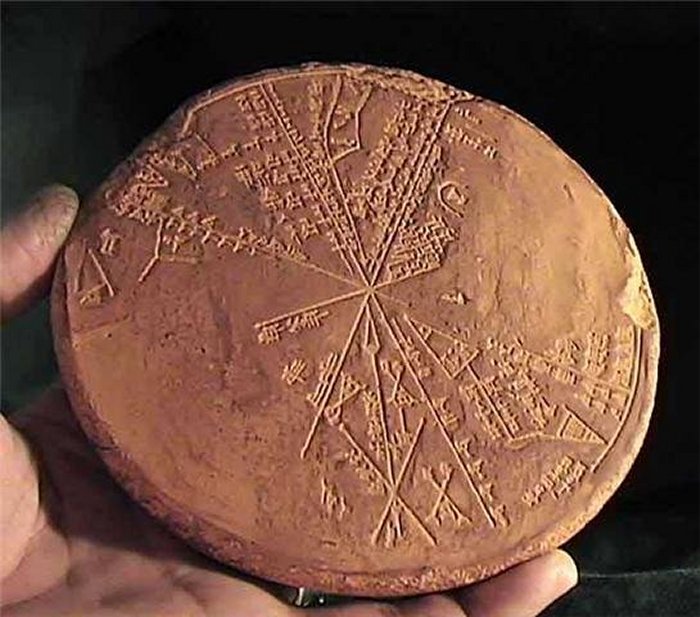Astronomy in Ancient Mesopotamia was both a bland of religion and astrology and a science, and its methods significantly influenced later Western astronomers.The Ancient Mesopotamians laid the foundation for all of modern Western astronomy.

Image source: http://aventalearning.com/content168staging/2008SocStudies6A/lesson4/html/page_14.html
Who were the first astronomers?
The first astronomers were the Sumerians, who mapped the stars into sets of constellations, many of which survived in the zodiac and were also recognized by the ancient Greeks. They were also aware of the five planets visible to the naked eye, Mercury, Venus, Mars, Jupiter, and Saturn, and also followed the movement of the stars.
In the 6th century B.C. Enuma’s scribes Anu Enlil were a group of Babylonian court men who were experts in astronomy and astrology. The texts refer to this group of scribes who for hundreds of years have kept accurate records of natural events on the earth and in the sky to predict the future.
Compared to later Babylonian clay tablets record the first total solar eclipse observed at Ugarit on May 3, 1375 BC.
Image source: https://search.creativecommons.org/photos/fb642196-2b69-430c-96c7-743c072f598c by Neo-Babylonian Empire-pt.svg: Szajci derivative work: Rowanwindwhistler

Image source: https://search.creativecommons.org/photos/b3151eba-49cc-4803-951c-99e3b19575d7 by Kevan
Which were the babylonian astronomical Innovations?

Image source: https://en.wikipedia.org/wiki/Venus_tablet_of_Ammisaduqa#/media/File:Venus_Tablet_of_Ammisaduqa.jpg

Image source: https://search.creativecommons.org/photos/2c1b0769-80d3-404a-996a-edbc72f02aaa by tonynetone

Image source: https://search.creativecommons.org/photos/eea81e09-69a2-4d5d-b0e7-21a455ca14c1 by tonynetone
The Babylonians were among the first to possess a functional theory of the planets. The Babylonian Venus tablet of Ammisaduqa, from the 7th-century BC, is the oldest surviving planetary astronomical text in which are show the observations of the motions of the planet Venus dating back to the second millennium BC. The Babylonian astrologers laid the foundations of Western astrology. In the 7th century BC of the Neo-Assyrian period was written the Enuma anu enlil which includes a list of omens regarding celestial phenomena and the motions of the planets.
For calculating the length of the Venus cycle the Babylonians developed a method where the length of a cycle was 587 days, rather than 584 days. This difference is due to the attempt to make these astronomical cycles coincide with the phases of the moon.
In Babylonian cosmology, the idea of geocentrism, where the center of the Earth is the exact center of the universe, did not yet exist, but it was established later by the Greek philosopher Aristotle’s On the Heavens. Rather, Babylonian cosmology suggested that the cosmos rotated circularly with the heavens and the earth. Like the Babylonians, the Sumerians believed in a plurality of heavens and earths. This idea dates back to Sumerian spells of the 2nd millennium BC, which refers to the existence of seven heavens and earths, perhaps chronologically linked to the creation by seven generations of Gods.
The constellations provided practical use for the people of ancient Mesopotamia. To mark seasons for harvesting or planting was used the orientation of the constellations. Some constellations have provided an accurate clock with which to measure time. The Babylonians had written records of calendars used for planting.
Babylonian astronomers, in the 12th century BCE, began to compile lists of visible stars, grouped into constellations. Many with Sumerian names, demonstrating the influence of Sumerian astronomy in Babylon. Some of the constellations identified by the Babylonians –such as Capricorn, Taurus, Scorpio, Leo, Gemini, and Cancer – are still recognized today.
One of the greatest discoveries of the Babylonians was their invention of the degree system to distinguish positions in the sky similar to the one currently used to calculate latitude and longitude. The degree system and many of the Babylonian constellations were adopted by the Greeks.

Image source: https://solariapublications.com/2011/10/25/map-2-full-reconstruction-of-the-babylonian-star-map/ by
Who were the Chaldeans?
In the later Babylonian Empire, the individuals responsible for studying the skies were known as Chaldeans. These priest-astronomers in addition to continuing to use the old star catalogs also developed mathematical models capable of anticipating astronomical events without consulting the registers. Thanks to this ability to “predict the future” the Chaldeans enjoyed positions of great power and respect.
Seleucus of Seleucia probably was the most famous Chaldean who lived around 200 BCE, who believed that the Earth and the other planets revolved around the Sun, as did Copernicus 1700 years later. Seleucus was also the first to suggest that the Earth’s tides and their height were caused by the Moon, and its position relative to the Sun.

Image source:https://search.creativecommons.org/photos/f32ad14f-f23a-4511-a008-454438cd6152 by kislakcenter
The evolution of the calendar
The Sumerians were the first to divide a circle into 360 parts, thus providing an angle measurement system still in use today. These shapes were invented to study the movements of the stars and planets. Based on their astronomical knowledge, the Sumerians developed the twelve-month calendar based on the cycles of the moon, probably to keep track of religious festivals and working days to pay workers.

Image source: https://search.creativecommons.org/photos/ce919384-88c5-4140-9182-60838ee484f6 by joebeone
The lunar calendar was synchronized with the solar year (the seasons) by interspersing a leap month every few years. The Sumerians of Babylon were probably the first to create a calendar by counting 12 lunar months as a year. The early Egyptians, Greeks, and Semitics copied this calendar, and later the Egyptians worked out a calendar that corresponded almost exactly to the seasons.



Images source: https://cte.univ-setif2.dz/moodle/mod/book/tool/print/index.php?id=15503
In ancient Sumer, there were two “seasons” in the Sumerian year – a “summer” season, Emesh, which began with the Vernal Equinox– and a “winter” season, Enten, which began with the Autumnal Equinox. The New Year was an important holiday and was celebrated around the Vernal Equinox, based on the synchronization of the lunar and solar calendars. The new year and month began after the completion of the old lunar year, with the first New Moon. The day contained twelve hours and began and ended at sunset.

Image source: https://search.creativecommons.org/photos/3ed2f4b3-b8e9-46c4-be77-f9cb25a8e0f8 by 826 PARANORMAL
There is a certain similarity between the ancient Sumerian calendar and the Hebrew one, for example, the Hebrew Passover which falls at the same time as the Sumerian New Year, and the beginning of the Hebrew Sabbath at the setting of the sun.
The early Romans also used a moon-based calendar where the year was 355 days long. The months of March, May, July, and October had 31 days each; February had 28, and the rest had 29. Every four years or so a month was added. The high priest regulated the calendar and in the calends, announced the times of the nones (first quarter) and the ides (full moon) of that month. The word calendar comes from the Latin word kalendae. The priests, however, did poorly in keeping the calendar and at the times of Julius Caesar, they had the summer months that came in spring. In this regard, Caesar corrected this situation and adopted the plan of the year of 365 days of the Egyptian astronomer Sosigenes, with the addition of one day every fourth, or leap year. He spread the extra ten days between the 29-day months. Julius Caesar’s correction of one day over four years made the solar year longer than the year of the seasons. In 1582 the vernal equinox occurred on March 11 instead of the correct date, March 21.
Pope Gregory XIII remedied this by making sure that ten days were eliminated from the calendar and that the day after Oct. 4, 1582, was October 15. He also ordered that three times in every 400 years the leap-year be omitted. This new calendar was called the Gregorian calendar, or New Style (N.S.). It was adopted by Roman Catholic countries, while the Protestant and Eastern Orthodox ones continued to use the Old Style (O.S.), or Julian calendar. The new calendar was adopted in England from 1752 when 11 days had to be dropped. The Eastern Orthodox church accepted the New Style in 1923 and the Chinese had adopted it in 1912. Another reform was the general adoption of January 1 as the start of the year. Until then some nations started it on December 25, others on January 1 or March 25.

Image source: https://search.creativecommons.org/photos/a0b26a3c-a492-4bfe-a7b9-502898b19c0f by Mike Licht, NotionsCapital.com
Info sources:
http://www.crystalinks.com/sumercalendars.html
http://www.thelivingmoon.com/43ancients/01documents/Mesopotamian_Astronomy.html
http://www.brighthub.com/science/space/articles/123842.aspx

Comments are closed.